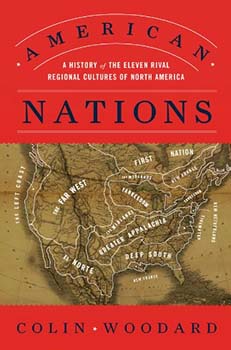 The presidential race already upon us whether we like it or not and the choices suck ass, as of today: Teabagger, Randroid and a DINO.
The presidential race already upon us whether we like it or not and the choices suck ass, as of today: Teabagger, Randroid and a DINO.
Mr. Woodard’s recent book makes an interesting argument about getting us to rethink the US, especially when it comes to our collective history and voting patterns. His premise isn’t original; previous historians, sociologists and authors have proposed the multiple nations within the countries theory. Woodard even referenced the popular nine-nation theory backed by GOP writer Kevin Philips who predicted the election of Reagan.
Let me give a quick synopsis. Ever since the ugly 2000 election cycle, the SCLM has continued to purport the lazy, inaccurate Red v. Blue narrative. It’s an oversimplification now and it has always been much like the American Revolution often boiling down to Revolutionaries v. Loyalists. Woodard claims there’s really 11 distinct nations. A couple tend to be traditional allies (Yankeedom and Left Coast v. Tidewater and Deep South) yet others switch coalitions depending upon the issues (Midlands, New Netherland, Far West and El Norte). One is definitely not monolithic so its members side against anyone they perceive as being the oppressive authority (Greater Appalachia).
The first ground rule Woodward lays down is the difference between a nation and a state:
- State: An area of land with (usually) well-defined borders and government. For example, the United Kingdom.
- Nation: A collection of people who share a common heritage via history, mindset, economics, etc. For example, the Kurds who reside in large numbers within at least two states, Turkey and Iraq.
This makes more sense since there’s an old joke about my former home state of Illinois, the people are divided in two main camps…Chicago and Northern Kentucky. It’s said mostly to poke fun at the people with “southern” accents, racist attitudes and White Trash behaviors. In all seriousness though, it does explain why the people of Central Illinois and vast swaths of Indiana vote against their own economic interests by electing the Republicans who destroyed the decent-paying jerbs.
I got ahead a little bit by explaining the Chicago v. Downstate feud Illinois has had for some time. I want to go over the first nine nations of North America according to Woodard:
- First Nation: The American Indians residing in northern Canada.
- El Norte: Mexico’s 30 northern states with the US’s southern Southwest.
- New France: Quebec and a dwindling section of Louisiana.
- Tidewater: Originated with the failed Jamestown colony in Virginia but took off after tobacco proved to be lucrative enough to offset the risks of death.
- Yankeedom: Most famous with its origin via the Pilgrims. Unlike its southern rival Tidewater, the settlers had a plan for self-governance without England.
- New Netherland: The commercial Dutch colony centered around the modern-day New York City. Oddly, the Dutch were in the minority even then.
- Deep South: Really a colony of Barbados-based slave plantation owners who brought their cruelty and militaristic culture with them.
- Midlands: Quaker millionaire William Penn’s colony open to all which later proved its undoing.
- Greater Appalachia: These Scots-Irish used Midlands to get in due to them being undesirable to the other colonies. Midlands should’ve listened, these pugnacious types fled to the mountains and beyond. Today they’re the stereotypical Rednecks.
What about the other two, the book says there’s 11. The remaining two were formed as the US expanded toward the Pacific Ocean.
- Left Coast: A Yankeedom colony set up to offset Greater Appalachian dominance as the latter moved westward.
- Far West: Mostly the US’s desert/prairie interior populated by resentful “individualists” dependent upon Federal funds yet scream the loudest when the welfare check is late.
Obviously there’s a whole lot more to the 11 nations, you’ll have to read the book for yourself to see what the other details are in the “characters” of their residents.
After Woodard establishes the core nations’ backgrounds, he gives his interpretation of American history through their interactions with each other and outside states. I already knew the American Revolution’s breakdown: New England and a lukewarm South fighting England with its Hessian auxiliaries. I learned that New York was more ambivalent, practically sympathetic to the Loyalists. The Greater Appalachian types also used the conflict to settle old scores against whoever they thought was screwing them locally. One thing Greater Appalachia did agree on was the American Indians residing on land they wanted. Explains why Andrew Jackson violated a Supreme Court decision to force the Cherokee Nation to relocate to Oklahoma.
This is followed by the US’s struggle to become a cohesive state: the Whiskey Rebellion, Jackson’s election, the Mexican-American War, the Civil War, Reconstruction, the Gilded Age and the remainder of the 20th century. One interesting argument he makes is the area/voting bloc collectively known as Dixie didn’t appear until the Reconstruction due to Greater Appalachia being divided by state lines in the Civil War. I have serious doubts the US was going to split into three or more countries before the attack on Fort Sumter. Even Lincoln had a wait-and-see attitude toward the Confederacy at the beginning.
I do take issue about some things in Woodard’s claims with the character of Yankeedom, New Amsterdam and Midlands; he downplays the influence of immigration. He says they conformed to the originators. I beg to differ especially when it comes to New England, the Irish Catholics certainly don’t share Unitarian values. Due to my dislike of “Dixie,” I would say he is spot on with the Deep South and Tidewater in their continued racist tendencies paired with the spreading Ayn Rand worship from the Far West. He also discounts any real pockets of nations within nations. For example, Austin is practically an island of Yankeedom in a sea of Greater Appalachia/Deep South. Why? Until recently, Austin tended to fight more for preserving the common good while the Texas Legislature has done everything to dismantle Austin’s laws to make us more like Houston/Dallas (both toilets with uninhibited “growth.”) which follow the Greater Appalachian mindset of the Earth being disposable. Black Americans get short shrift too. I highly doubt they share the values of Tidewater and Deep South beyond religious devotion.
So which nation do I belong to? Personally, I feel I’m a Yankee by conviction with touches of the Left Coast since the environment is important. As FDR said, forests are the world’s lungs, it would be wise to preserve them. I did grow up in an area overrun by Greater Appalachian which I completely agree with Woodward about yet the Central Illinois I come from still has elements of Midlands, the original inhabitants until the were outnumbered by migrating Kentuckians in WWII. My family definitely fit the Midlands pattern but I think it’s more of a generational matter with issues such as Civil Rights: (Grandma said MLK was a Communist), Marriage Equality (I clearly remember my mother openly opposing the ERA movement). While they aren’t willing to sick their necks out as much as I will, they openly despise the Republican party thanks to its past association with the Know-Nothings.
Woodward gave me much to ponder and reconsider. I have often agreed with what is labeled the Marxist Theory of history, class (or economic) struggles are a huge factor driving events. Woodward entertains it, especially with Greater Appalachia’s violent patterns, New Netherlands’ sociopathic tendencies to wreck the economy and Deep South’s hostility toward any who question their authority. It’s not the Rosetta Stone about America’s internal quarrels. It is a good start nonetheless.
